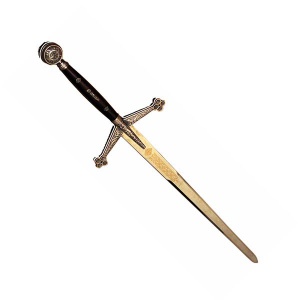Claymore
| Interwiki |
|---|
|
български • Deutsch • English • Español • Esperanto • Français • Italiano • Lietuvių • Lojban • Nederlands • Polska • Português • Русский • Suomi • Svenska • Türkçe • 中文 |
| |||||||||||||||||||||||||||||||||||
Description and uses
The claymore is one of the most expensive and powerful weapons in Cantr, surpassed only by the steel battle axe and crossbow. It requires large amounts of steel to build, making it economically inefficient compared to other swords like the steel sabre or steel rapier.
The advantage of the claymore is that it is almost as powerful as the two stronger weapons, but has a much lower skill weighting. For characters who can afford the claymore, but are awkward fighters; you will want to use the claymore.
Real-life context
The term claymore has been used to describe two distinct types of swords used by Scottish warriors and soldiers. The name claymore is thought to be an anglicisation of claidheamh mòr a Gaelic term meaning "big sword", though another theory claims it comes form "claidheamh da lamh", literally two-hand sword. Claidheamh is ultimately cognate with Latin gladius
The first was a large, two-handed sword used in the medieval period. It was used in the constant clan warfare and border fights with the English from circa 1300 to 1700. The last known battle in which it is considered to have been used in a significant number is Battle of Killiecrankie in 1689. It was somewhat smaller than other two-handed swords of the era, and was widely feared because its lightness made it faster in combat than its European counterparts. The two-handed claymore seems to be an offshoot of Early Scottish medieval swords which had developed a distinctive style of a cross-hilt with downsloping arms that ended in spatulate swellings. The average claymore ran about 55 inches (1.4 m) in over all length, with a 13 inch (330 mm) grip and a 42 inch (1 m) blade. Fairly uniform in style, the sword was set with a wheel pommel often capped by a crescent shaped nut and a guard with straight, down-sloping arms ending in quatrefoils and languets running down the center of the blade from the guard.
The second, later, sword to be so designated was a one-handed basket-hilted broadsword popular with Scottish troops in the 18th and 19th centuries. The basket was designed to protect the hand in combat. The latter form of claymore can be seen in some forms of Scottish traditional dance.
The above information was taken from the Wikipedia article at http://en.wikipedia.org/wiki/Claymore.
